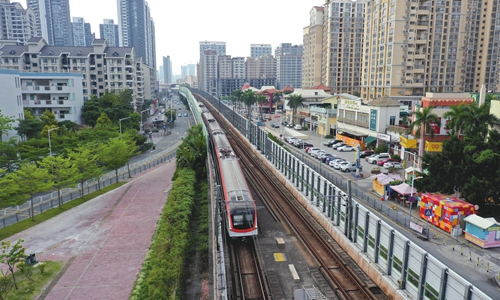A massive intercity rail plan for the Guangdong-Hong Kong-Macao Greater Bay Area has been revealed. It will provide a much-needed boost for cities in one of the world’s biggest metropolitan areas, particularly the two special administrative regions (SARs) which are in dire need of a tailwind to fend off a coronavirus-induced recession.
The National Development and Reform Commission (NDRC), China’s top economic planner, revealed in an announcement on Monday that it has agreed to implement a raft of intercity rail projects in the Greater Bay Area. The rail plan envisions incorporating standard, high-speed and commuter railways, creating a multi-layered rail network that will allow users to travel between major cities in the Greater Bay Area within one hour.
The rail network will hit 4,700 kilometers by 2025, according to the plan, and will reach 5,700 kilometers to fully cover cities above the county level by 2035. Sections of the network will begin operations while others remain under construction.
The plan includes 13 intercity railways and five terminal projects and has a short-term total mileage goal of 775 kilometers, involving investment of 474.1 billion yuan ($68.12 billion). Half that investment will be provided by local fiscal coffers in Guangdong Province and the cities along the rail route. The network will be accessible to social capital and bank loans, among other funds, which will account for the other half of the investment.
“As a native of the Greater Bay Area, I think such infrastructure projects can funnel more investment into the area, thus creating jobs and boosting regional economic development,” Liang Haiming, chairman of the China Silk Road iValley Research Institute, told the Global Times on Tuesday.
The rail network is set to provide greater convenience and facilitate flows of talent, logistics, capital and information between Guangdong, Hong Kong and Macao. It is also propitious to improving cooperation between cities in the metropolitan area, particularly when it comes to the introduction of high-end resources and advanced rules and models from the two SARs, Liang went on to say, noting that the network would make it easier for city dwellers in Guangdong to visit Hong Kong and Macao, stimulating tourism and businesses in the two cities.
Economic boost
For the two SARs mired in COVID-19-inflicted economic hardships, the planned railway network is arguably a beacon of hope.
In a research report recently sent to the Global Times, DBS economist Samuel Tse said that “Hong Kong is now in its longest recession.” The city posted a real GDP contraction of 9 percent year-on-year in the second quarter, almost as weak as the reading for the previous quarter – a 9.1 percent contraction. On a quarterly basis, Hong Kong’s GDP contracted 0.1 percent further after falling for five consecutive quarters.
The recent resurgence of COVID-19 has seemingly heightened woes over the city’s economic outlook.
The bank has ratcheted down its GDP forecast for 2020 to a contraction of 7 percent from a previous 4 percent decline prediction, according to Tse.
Macao’s GDP plunged by 48.7 percent in real terms in the first quarter from the year before, local official data showed.
Sagging external demand and a fatal blow to tourism services amid the COVID-19 pandemic have apparently subjected both cities to almost unprecedented growth woes.
In an attempt to reinvigorate growth, the NDRC aims to integrate Macao into the national rail network by connecting Zhuhai’s high-speed and intercity railways with Macao’s light rail transit network, adding to existing links between Shenzhen and Hong Kong.
Among the prospects of the Chinese economy – which has tended toward optimism in its outlook on the medium and long terms despite global uncertainties – is a consumption upgrade. There are currently three networks underpinning the economy’s reawakening of its consumption engine – the new transport network, the new-generation mobile network and the new urbanization network – Cheng Shi and Qian Zhijun, economists at ICBC International, told the Global Times last week.
The plan is of particular significance to Hong Kong as it will allow the city to flex its muscles as a financial hub, better integrating itself into the national push for financial sophistication, Ding Meng, an economist at the Bank of China (Hong Kong), told the Global Times on Tuesday.
Ding said that links between talent, legal systems and markets in the mainland and the two SARs also need to be improved in the future.
A train pulls into Minle Station on Shenzhen Metro Line 4 in Guangdong Province on April 26, 2020. Photo: cnsphoto


